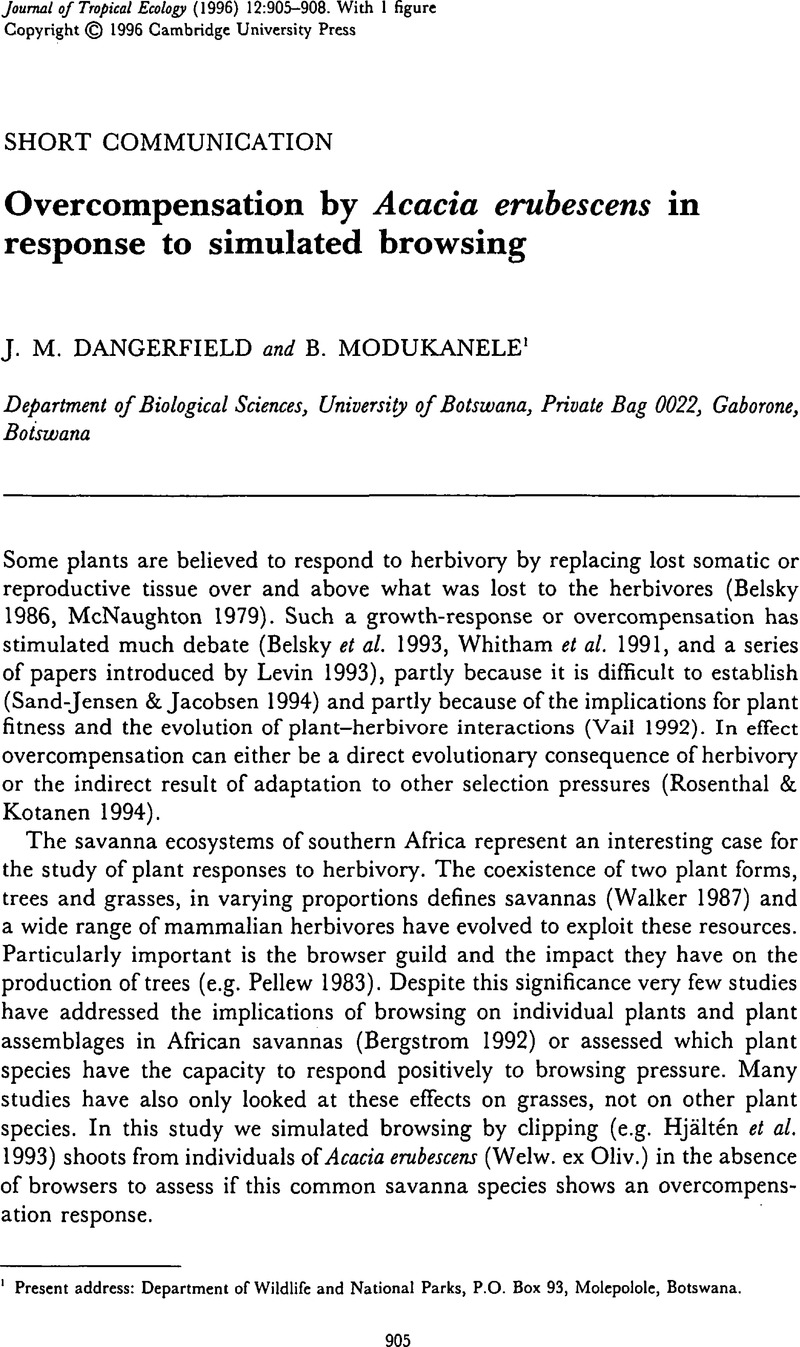Crossref Citations
This article has been cited by the following publications. This list is generated based on data provided by Crossref.
Haukioja, Erkki
and
Koricheva, Julia
2000.
Tolerance to herbivory in woody vs. herbaceous plants.
Evolutionary Ecology,
Vol. 14,
Issue. 4-6,
Karlsson, P. S.
and
Weih, M.
2003.
Long‐term patterns of leaf, shoot and wood production after insect herbivory in the Mountain Birch.
Functional Ecology,
Vol. 17,
Issue. 6,
p.
841.
Cooper, S. M.
Owens, M. K.
Spalinger, D. E.
and
Ginnett, T. F.
2003.
The architecture of shrubs after defoliation and the subsequent feeding behavior of browsers.
Oikos,
Vol. 100,
Issue. 2,
p.
387.
HATTORI, Kouhei
ISHIDA, Takahide A.
MIKI, Kaori
SUZUKI, Mayuko
and
KIMURA, Masahito T.
2004.
Differences in response to simulated herbivory between Quercus crispula and Quercus dentata.
Ecological Research,
Vol. 19,
Issue. 3,
p.
323.
Scogings, P.F.
2005.
Rapid chemical responses of Acacia karroo to early dormant season defoliation in a semi-arid subtropical savanna.
Journal of Arid Environments,
Vol. 62,
Issue. 2,
p.
225.
Milewski, Antoni V.
and
Madden, Derek
2006.
Interactions between large African browsers and thorny Acacia on a wildlife ranch in Kenya.
African Journal of Ecology,
Vol. 44,
Issue. 4,
p.
515.
Fornara, D. A.
and
Toit, J. T. Du
2007.
BROWSING LAWNS? RESPONSES OFACACIA NIGRESCENSTO UNGULATE BROWSING IN AN AFRICAN SAVANNA.
Ecology,
Vol. 88,
Issue. 1,
p.
200.
Stevens, Michael T.
Waller, Donald M.
and
Lindroth, Richard L.
2007.
Resistance and tolerance in Populus tremuloides: genetic variation, costs, and environmental dependency.
Evolutionary Ecology,
Vol. 21,
Issue. 6,
p.
829.
Scogings, P.F.
and
Mopipi, K.
2008.
Effects of water, grass and N on responses of Acacia karroo seedlings to early wet season simulated browsing: Leaf N, fibre and tannin concentrations.
Journal of Arid Environments,
Vol. 72,
Issue. 9,
p.
1666.
Skarpe, Christina
and
Hester, Alison J.
2008.
The Ecology of Browsing and Grazing.
Vol. 195,
Issue. ,
p.
217.
Scogings, P.F.
and
Mopipi, K.
2008.
Effects of water, grass and N on responses of Acacia karroo seedlings to early wet season simulated browsing: Aboveground growth and biomass allocation.
Journal of Arid Environments,
Vol. 72,
Issue. 4,
p.
509.
Dharani, N.
Kinyamario, J. I.
Wagacha, Peter W.
and
Rodrigues, Anthony J.
2009.
Browsing impact of large herbivores on Acacia xanthophloea Benth in Lake Nakuru National Park, Kenya.
African Journal of Ecology,
Vol. 47,
Issue. 2,
p.
184.
SCOGINGS, PETER F.
MAMASHELA, THANDEKA C.
and
ZOBOLO, ALPHEUS M.
2013.
Deciduous sapling responses to season and large herbivores in a semi‐arid African savanna.
Austral Ecology,
Vol. 38,
Issue. 5,
p.
548.
Scogings, P.F.
Hjältén, J.
and
Skarpe, C.
2013.
Does large herbivore removal affect secondary metabolites, nutrients and shoot length in woody species in semi-arid savannas?.
Journal of Arid Environments,
Vol. 88,
Issue. ,
p.
4.
Root-Bernstein, Meredith
Guerrero-Gatica, Matías
Piña, Luis
Bonacic, Cristián
Svenning, Jens-Christian
and
Jaksic, Fabián M.
2017.
Rewilding-inspired transhumance for the restoration of semiarid silvopastoral systems in Chile.
Regional Environmental Change,
Vol. 17,
Issue. 5,
p.
1381.
Scogings, Peter Frank
and
Gowda, Juan H.
2019.
Savanna Woody Plants and Large Herbivores.
p.
489.
Gorné, Lucas D.
and
Díaz, Sandra
2022.
Herbivory, intraspecific trait variability and back to herbivory.
Oikos,
Vol. 2022,
Issue. 6,
Finley, Jenna V
Aarssen, Lonnie W
and
Schmid, Bernhard
2022.
No evidence of a generalized potential ‘cost’ of apical dominance for species that have strong apical dominance.
Journal of Plant Ecology,
Vol. 15,
Issue. 6,
p.
1168.





